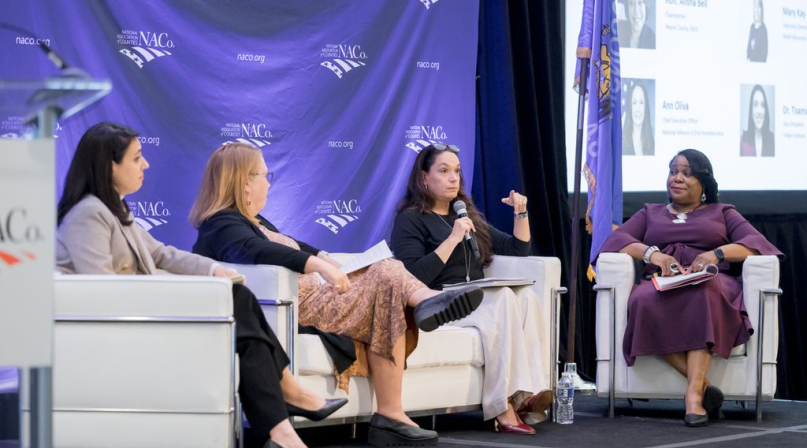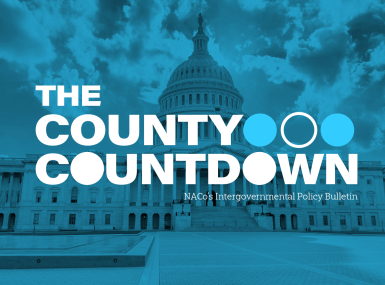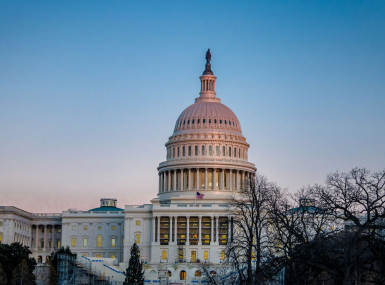Federal policy shifts spark housing policy talks at LUCC Symposium

Key Takeaways
Housing initiatives and funding streams that have helped local governments address homelessness are set to change or be cut under new federal guidelines, so counties are looking at alternative avenues to provide access to housing and supportive social services to their most vulnerable populations, panelists said Oct. 9 at NACo’s Large Urban County Caucus business meeting in Milwaukee County, Wis.
People experiencing homelessness have a broad range of, often acute, physical and behavioral health needs, so “what’s really important are comprehensive care delivery models that enable them to thrive in the community,” said Dr. Tisamarie Sherry, vice president of the health policy division at Urban Institute, a Washington, D.C. think tank. The contemporary models addressing homelessness that have the strongest evidence supporting them are those that adopt a “Housing First” approach and framework, such as permanent supportive housing, she noted.
The Housing First model provides housing to homeless people with no strings attached. The approach doesn’t require participants to undergo treatment for substance use disorder or mental health needs, instead providing voluntary linkages to comprehensive support services, such as specialty behavioral health treatment, case management, peer support, harm reduction and supported employment.
An executive order issued in July by President Trump, titled “Ending Crime and Disorder on America’s Streets,” directs federal agencies to stop supporting Housing First policies, stating that they “deprioritize accountability and fail to promote treatment, recovery and self-sufficiency.”
Measurable results
Urban Institute worked with the City and County of Denver to assess its Housing First program and found that it achieved a 40% reduction in arrests and a 40% reduction in emergency room visits, compared to “usual care” in the community, which involved people moving in and out of shelters and involuntary treatment engagement methods, according to Sherry.
Implementation of the Housing First model has led to “dramatic increases in voluntary engagement with outpatient medical treatment, behavioral health treatment, use of appropriate prescription medications,” Sherry said. “And so, it has really demonstrated quite resoundingly that with giving people access to housing and voluntary service engagement, we can achieve really remarkable outcomes across a range of different domains.”
Medicaid changes
As the largest payer for behavioral health services across the country, Medicaid is a “critical source of coverage for people experiencing homelessness,” Sherry said.
H.R. 1, legislation Congress passed in July, is bringing many changes to Medicaid, including eligibility, financing and verification processes, that could disproportionately impact people experiencing behavioral health conditions, Sherry noted. Other reductions in federal resources that serve individuals with complex behavioral health needs who are experiencing homeless, including cuts to Substance Abuse and Mental Health Services Administration (SAMHSA) and healthcare workforce programs, will exacerbate the issue, as well, she added.
“Financing the care continuum has really been challenged long term, and it’s about to get more challenging,” Sherry said. “… “The data tells us that we have a population where behavioral health needs are becoming more complex.
“In particular, we’re seeing a much more prominent picture of substance use disorder complicating communities’ ability to serve people, at a time when, over the next couple of years, we’re going to be seeing significant reductions in federal resources available to support the population, and also some more burdens on people who are trying to access the services and remain enrolled in it.”
Affordable housing
To tackle homelessness, counties need to invest in supportive services (people with substance use disorder and mental illness disproportionately experience homelessness, and rates are even higher for people who have both), while also not losing focus on the primary driver of homelessness: a lack of affordable housing, according to Ann Olivia, chief executive officer of the National Alliance to End Homelessness.
“For many, many unsheltered people, their behavioral health conditions are exacerbated, or created, by the fact that they are living on the streets in really terrible conditions,” Olivia said. “… Housing is the driver, and also the solution, to this issue.”
In accordance with the executive order, HUD will now cap permanent housing options at 30% of what any community can apply for. Right now, it’s at 87%, according to Olivia. Around 170,000 people who have behavioral health conditions, physical health conditions and co-morbidities who have gotten themselves out of homelessness and into stable housing will lose their housing under this plan, she noted.
Reach out to congressional representatives
“We at the Alliance are asking you all to reach out to your congressional delegations and talk about what the impact will be in your community, if suddenly all permanent housing options funded to continued care get defunded,” Olivia said. “Because that is exactly what they are planning to do, and that is part of the implementation for the executive order.”
The shift in priorities in addressing homelessness at the federal level places more burden on local governments without providing them the resources or flexibility needed for success, according to Mary Kay Battagalia, executive director of National Alliance on Mental Illness (NAMI) Wisconsin.
“The biggest problem with this executive order, as I see it, is there’s no real authority of resources to help the counties with this,” Battagalia said. “There’s no real money involved in ‘How am I going to do this?’
‘Sweeping folks up’
“… So, at the same time we’re cutting Medicaid, at the same time they’re saying they want to cut Housing First models in the executive order, and at the same time, we’re talking about sweeping folks up and putting them somewhere, with no place to put them — I don’t know how you execute this.”
The growing effort to curb the visibility of homelessness, which has included breaking up homeless encampments, doesn’t address the root of the issue, and makes it more difficult to assist people in need of support, according to Olivia.
“While there may be less visible tents, there are no less people experiencing homelessness,” Olivia said. “They’re just harder to find. They’re in Rock Creek Park [in Washington, D.C.], they’re hiding in the library during the day, so it’s very frustrating to our local provider network, who are trying hard to find people that they’ve been working with for a long time, being a lot of them have moved to places that are much less visible.”
Every state in the country except for Oregon and Wyoming have at least one law criminalizing forms of homelessness through measures such as restricting camping, sitting, lying, loitering, panhandling or living in vehicles. Despite a Florida law criminalizing public camping and sleeping on public property, Miami-Dade County has “one of the best continuums of care in the country,” because it has a local tax base dedicated to its homeless services system, which is a great example of a way progress can be made at the local level, Olivia said.
“Because they have a local food beverage tax in the county, they are able to supplement what they get from HUD and move people into permanent, supportive housing and other types of interventions in Miami,” Olivia said. “But again, criminalization — finding, taking and arresting people — isn’t actually the thing that’s working. The thing that’s working is the fact that Miami has such a strong system, and they’re moving people in it.”
Leveraging state dollars
Counties should leverage more state dollars to build housing and services and work to access Home Investment Partnerships Program (HOME) and Community Development Block Grant Program (CDBG) funding, as well as low-income housing tax credits, Olivia said.
The National Alliance to End Homelessness published a toolkit around what it calls “interim strategies,” to keep people housed while organizations and local governments pursue long-term solutions. The strategies include ensuring emergency shelters are low-barrier and housing-focused and that food outreach teams are partnering with local entities who have access to housing resources, Olivia noted.
During the COVID-19 pandemic, many local governments used old hotels as non-congregate shelters — if counties have the option to, they should continue to utilize that, along with sprung structures, Olivia said. San Diego County, Calif. worked with the city to build sprung structures (large tents that have HVAC in them), as a temporary solution to get people off of the street, so that the county could move forward on some of its big-picture, longer-term housing goals, she noted.
“So, there are things that we can do in these parallel tracks that will help us get people off the street, be as safe as possible, be as healthy as possible and also not lose our focus on the solutions that actually work,” Olivia said.
With so many changes trickling down from the federal government to localities, it would be easy to give in to fear and uncertainty, but it’s more important than ever to focus on the good work that’s being done on-the-ground and for local governments to step up and support the people who need it the most, Olivia said.
“Progress is going to be made in states and localities for the next several years, so take that really seriously,” Olivia said. “Don’t get distracted by all the noise that is out there. Stick to the thing that you know works and do your best to show up for the people who are vulnerable.”
Related News

County Countdown – Nov. 4, 2025
Every other week, NACo's County Countdown reviews top federal policy advocacy items with an eye towards counties and the intergovernmental partnership.
County News
Housing authorities push regional approach to affordable housing


